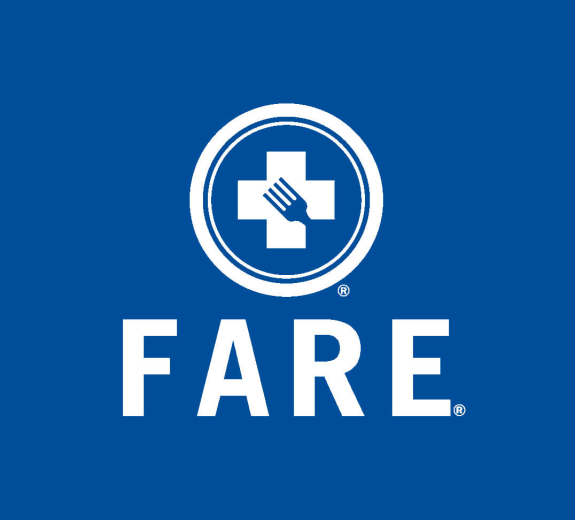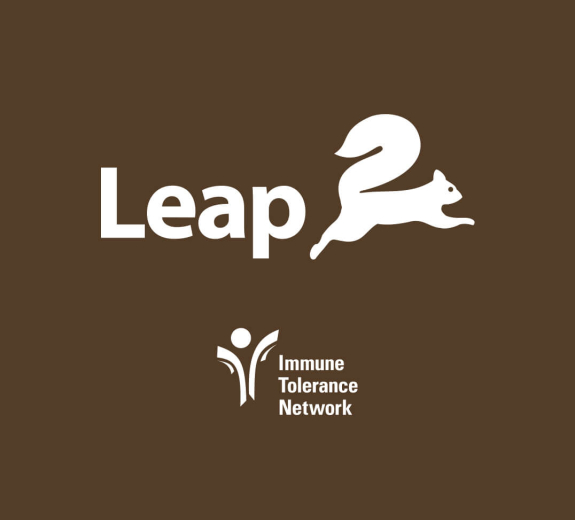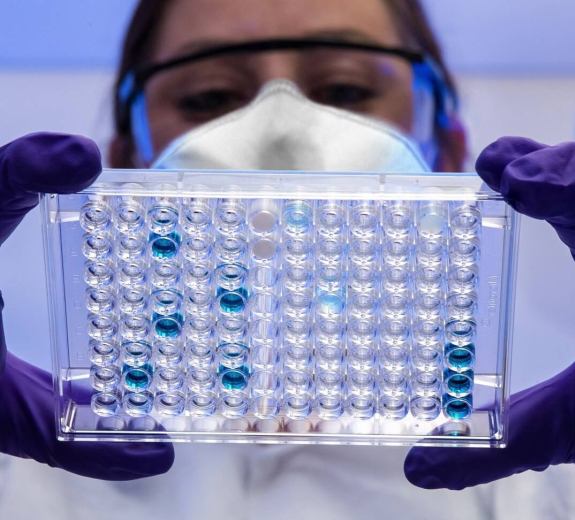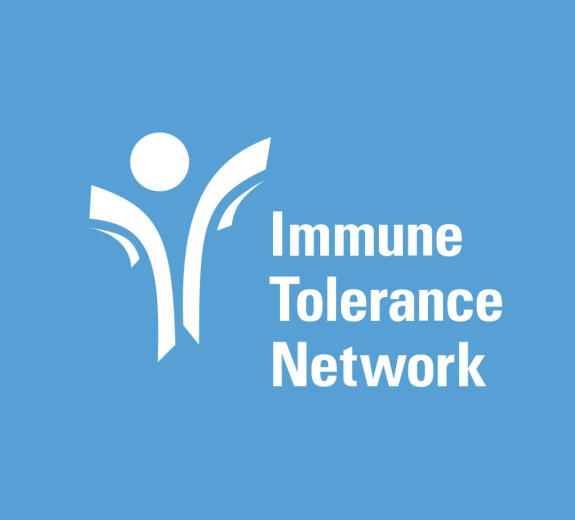
Virginia Mason and its affiliate Benaroya Research Institute (BRI) are among the newest members of the Food Allergy Research & Education (FARE) network, a leading nonprofit organization working on behalf of the 15 million Americans with food allergies.
FARE announced its expansion today to now include Virginia Mason and Benaroya Research Institute; Columbia University Medical Center and NewYork-Presbyterian/Morgan Stanley Children’s Hospital in New York; Gores Family Allergy Center at Children’s Hospital Los Angeles; ‘Specially for Children, an affiliate of Dell Children’s Medical Center of Central Texas, an Ascension hospital in Austin; and University of Utah Health Care/Primary Children’s Hospital in Salt Lake City.
“We’re honored to have been selected to participate in the important work the FARE network is leading to improve safety and quality of life for individuals coping with food allergies,” said David Jeong, MD, a food allergy researcher and section head for allergy and immunology at Virginia Mason. “We are eager to collaborate with other centers of excellence across the nation to address this health issue through clinical research and discovery.”
“We’re delighted to join the FARE network to accelerate the development of life-saving diagnosis and treatment for people suffering with food allergies,” says BRI President Jane Buckner, MD. “In partnership with Virginia Mason clinicians, we’re increasing scientific knowledge about how allergies occur and pioneering the development of biomarkers for diagnosis, patient monitoring and prognosis in allergies. We’re honored to be counted among leaders in food allergy research, translating research in the laboratory to the clinic and back again.”
Launched in 2015, the FARE Clinical Network strives to accelerate the development of drugs for patients with food allergies as well as improve the quality of care for this serious illness. The network is made up of 28 leading research and care sites nationwide and represents an investment by FARE of approximately $2.7 million annually. In approximately one year, FARE Clinical Network centers served more than 56,000 patients with food allergies, with more than one-third of those patients new to the centers, reinforcing the urgent need for initiatives such as the network. FARE Clinical Network, an initiative that aims to accelerate the development of drugs for patients with food allergies as well as improve the quality of care for this serious illness.
Food allergy, the abnormal response to a food triggered by the body’s immune system, affects an estimated 6 to 8 percent of children under age 3 and up to 3 percent of adults, according to The Mayo Clinic.
“Accelerating the pace of research on food allergies and helping to ensure that we can expand access to clinical trials and high-quality medical care is one of FARE’s top priorities,” said James R. Baker, Jr., MD, CEO and chief medical officer of FARE. “The addition of five exemplary institutions to the FARE Clinical Network enables FARE to significantly broaden the reach of this initiative.”
FARE Clinical Network centers serve as sites for clinical trials for development of therapeutics and best practices for the care of patients with food allergies. The FARE Clinical Network is a powerful driver of collaboration to advance the field of food allergy, with member centers contributing to the development of a national food allergy patient registry. FARE plans to further expand the network to 40 to 50 sites within the next three years.
Members of the FARE Clinical Network are selected through a comprehensive, rigorous application process. The centers of excellence selected as part of the FARE Clinical Network provide high-quality clinical and sub-specialty food allergy expertise and services, and are focused on applying new evidence-based knowledge to this important field. These centers also meet high standards for clinical care, teaching and clinical research. View the full list of FARE centers of excellence.
“The FARE Clinical Network is a brilliant way to jump-start regional food allergy centers,” said Stephen Tilles, MD, a member of the FARE Clinical Advisory Board Executive Committee. “In our case at the Northwest Asthma and Allergy Center in Seattle and at centers across the country, FARE has provided funding that is critically needed in order to maintain a high quality food allergy center, contributing toward the acceleration of food allergy research and the availability of new treatments for patients. FARE support offsets costs for research coordinators who help manage the process of complex clinical trials, facilitating access to these trials for the patient community.”
In adults, foods that most often trigger allergic reactions include fish, shellfish, peanuts, and tree nuts, such as walnuts. Problem foods for children can include eggs, milk, peanuts, tree nuts, soy, and wheat, according to the National Institutes of Health. The allergic reaction may be mild. In rare cases it causes a potentially life-threatening reaction called anaphylaxis. Symptoms of food allergy may include itching or swelling in the mouth; vomiting, diarrhea, or abdominal cramps and pain; hives or eczema; tightening of the throat and trouble breathing; and/or drop in blood pressure. FARE recommends individuals managing food allergies meet with their physicians to discuss their individual needs in order to inform their personal healthcare decisions.
“The breadth of research from the laboratory, translated into clinical treatment and back to the laboratory is really all under ‘one roof’ here,” says Jerry Nepom, MD, PhD, “forming a dynamic collaboration to find the best treatments for people with allergic disease.”
BRI scientists are studying the immune response in the children from the Learning Early about Peanut Allergy (LEAP) study. The study, published in February of 2015, received a lot of scientific and media attention because of its dramatic success in preventing peanut allergies. It found that introducing peanut protein into an infant’s diet beginning between 4-11 months of age greatly reduced the subsequent development of peanut allergies measured when the kids were 5 years old. The LEAP study was designed and conducted by the Immune Tolerance Network, which is led by BRI.
BRI’s current research into the immune response from the LEAP study is utilizing novel profiling tools developed by Drs. Erik Wambre, Bill Kwok, and Peter Linsley. “Our studies will analyze the molecular and cellular mechanisms that explain the difference between an allergic and a non-allergic immune response to peanut,” explains Erik Wambre, PhD, BRI assistant member. These studies also are designed to identify children who may benefit from similar therapies in the future.
Food allergy research at BRI, led by William Kwok, PhD, and Dr. Wambre, is an exciting addition to BRI’s other allergy research projects involving inhalant allergens such as grass pollen and mold allergies. Performed in collaboration with Virginia Mason physicians Mary Farrington, David Robinson and David Jeong, BRI’s investigators are taking a new approach to improve allergy vaccine therapy. They are using tetramers to identify the small pieces of allergen molecules that may initiate a beneficial immune response capable of blocking allergy; by monitoring patients with these tetramers and related techniques, safer and better approaches to therapy are envisioned. “The work currently being done at BRI will continue to shed light on the fundamental immune processes involved in the development of immune tolerance,” adds Mary Farrington, MD, BRI clinical researcher and Virginia Mason allergist.
For more information on food allergies and the research that BRI is currently conducting in this area, attend BRI’s Illuminations Luncheon on October 30 or visit our Allergies & Asthma page.
A new exhibit that explores the science of food allergies, “Allergies: Game On,” is now open as part of the Pacific Science Center’s Professor Wellbody’s Academy of Health & Wellness. The exhibit features information about food allergies, from global trends to the chemical reactions behind allergic reactions and personal stories about living with food allergies.
Seattle is a hub for food allergy research, with physicians, researchers and organizations from around the area collaborating to understand food allergies and identify better ways to treat and prevent them. The exhibit features some of the work being done at BRI by Drs. William Kwok, Eddie James, Mary Farrington and Steven Ziegler.
At “Allergies: Game On,” on display until June 7, 2015, you can test your knowledge by taking the Allergy Quiz, solve a T cell recognition puzzle, watch a videos with allergy researchers and individuals living with food allergies, fish for T cells, and even talk with local scientists who conduct allergy research on the first Saturday of each month.
The results of the Immune Tolerance Network’s (ITN) “Learning Early About Peanut” (LEAP) study published today in the New England Journal of Medicine demonstrate that consumption of a peanut-containing snack by infants who are at high-risk for developing peanut allergy prevents the subsequent development of allergy. The LEAP study, designed and conducted by the ITN with additional support from FARE and led by Professor Gideon Lack at Kings College London, is the first randomized trial to prevent food allergy in a large cohort of high-risk infants. Benaroya Research Institute at Virginia Mason (BRI) leads the ITN.
Peanut allergy is an aberrant response by the body’s immune system to harmless peanut proteins in the diet. The prevalence of peanut allergy has doubled over the past 10 years in the US and other countries that advocate avoidance of peanuts during pregnancy, lactation, and infancy. The LEAP study was based on a hypothesis that regular eating of peanut-containing products, when started during infancy, will elicit a protective immune response instead of an allergic immune reaction.
Over 600 children between 4 and 11 months of age at high risk for peanut allergy were randomized to either consume or avoid peanut until age 5 in order to compare the incidence of peanut allergy between the two groups. Children in the peanut consumption arm of the trial ate a peanut-containing snack-food at least three times each week, while children in the peanut avoidance arm did not ingest peanut-containing foods.
Of the children who avoided peanut, 17% developed peanut allergy by the age of 5 years. Remarkably, only 3% of the children who were randomized to eating the peanut snack developed allergy by age 5. Therefore, in high-risk infants, sustained consumption of peanut beginning in the first 11 months of life was highly effective in preventing the development of peanut allergy.
“For decades allergists have been recommending that young infants avoid consuming allergenic foods such as peanut to prevent food allergies,” notes Professor Lack, the lead investigator for the LEAP study. “Our findings suggest that this advice was incorrect and may have contributed to the rise in the peanut and other food allergies.”
Analysis data and figures from the published manuscript are available to the public on the ITN’s clinical research portal, TrialShare.
Scientists at Benaroya Research Institute at Virginia Mason (BRI) recently received a $2.2 million grant from the National Institutes of Health to find a unique biomarker that initiates and drives allergies. This grant expands on previous discoveries that led to the isolation of a type of white blood cells that show up only in people with allergic disease.
“We hope to identify a biomarker at the top of the allergic chain reaction that will predict the onset of allergy and will lead to novel vaccine approaches,” says Erik Wambre, PhD, BRI Principal Investigator for the grant. “Our aim is to develop a simple blood test to predict the likelihood of resolution of an allergy during therapy and to identify people who will develop an allergy before the first symptoms are experienced. This is especially important in at-risk people such as children with a life-threatening food allergy.”
BRI investigators will focus on a specific white blood cell, a rare type of T cell, identified in earlier work by Dr. Wambre as a key initiator of the allergic response. T cells are a part of the immune system that orchestrate immune response and that generally protect the body from bacteria, viruses and parasites. But sometimes T cells make mistakes that harm the body such as attacking tissues causing autoimmune diseases or overacting to a foreign substance (an allergen) such as food, pollen or animal dander that in most people is generally harmless. People react to the proteins in these allergens with an antibody that releases chemicals that cause sneezing; itching in the nose, eyes and ears; and in rare cases the life-threatening reaction anaphylaxis.
Allergies are probably the most common immune disease in the industrialized world, affecting about 50 million people in the U.S. and 60 million people in Europe. It is estimated that by 2050 about one in two people will have allergies. These diseases represent a major public health concern in terms of quality of life, drug-related costs or even mortality. The reason for the increase in allergies isn’t known but modern living seems somehow to make people’s immune systems overly sensitive.
“Allergen-specific immunotherapy is currently the only curative treatment in allergies and has been used for the past 100 years,” says Dr. Wambre. “However, this approach doesn’t always work, is only limited to a few allergens at a time and it can take two to five years to build up immunity. Part of the reason for this is that researchers still don’t fully understand the precise mechanism of how allergies work in the body. Until now, there has been no biological measurement to predict who is likely to have these diseases until the development of clinical symptoms. Currently, physicians diagnose allergies based on clinical history and measurement of specific antibodies and skin reactivity to an allergen. However, the diagnosis may not be correct because of the number of variables involved. If we can identify the biomarkers at the beginning of the allergic chain reaction we can get ahead of the symptoms and try to find a therapy that will eliminate the allergy at the first step.”
Young children who receive liver transplants are often faced with a lifetime of taking immunosuppressive medications to suppress their immune system so their transplanted liver is not rejected. In a recently reported clinical research study by the Immune Tolerance Network (ITN), Sandy Feng, MD, PhD, Professor of Surgery at the University of California, San Francisco, led a trial that successfully enabled 12 of 20 young children to stop medication without liver rejection. This offers tremendous hope for these children to live free from immuno-suppression drugs.
This type of breakthrough medical research is at the heart of the ITN's mission to establish new treatments for diseases of the immune system. BRI Director Gerald Nepom, MD, PhD, recently completed his first year as director of the ITN, leading one of the largest government funded clinical research networks working worldwide. The ITN is funded by the National Institute of Allergy and Infectious Diseases (NIAID), part of the National Institutes of Health (NIH), in partnership with the Juvenile Diabetes Research Foundation (JDRF).
"There are many opportunities to utilize the expertise of both BRI and the ITN to expand and energize research on autoimmune and immune-mediated diseases," says Dr. Nepom. "The ITN conducts pioneering human studies that are designed to create dramatic new ways to treat these diseases. BRI is a hotbed of expertise in laboratory science and advancing the latest research into clinical trials."
"The ITN is currently conducting 27 innovative clinical research trials internationally," says Sarah Sanford, Network Administrative Director for the ITN. "We research specialized immune tolerance therapies for the prevention of organ transplant rejection in liver, kidney and islet transplantation, the treatment of autoimmune diseases such as Type 1 diabetes, multiple sclerosis, lupus and others, and the prevention and treatment of allergies and asthma."
Many treatments for autoimmune and immune-mediated diseases suppress the entire immune system, leaving patients more vulnerable to viruses, bacteria and even certain types of cancer. In immune tolerance therapies, drugs target only the parts of the immune system that have gone awry. Both BRI and the ITN are working on these pioneering treatments. For more information about the ITN, visit immunetolerance.org.







